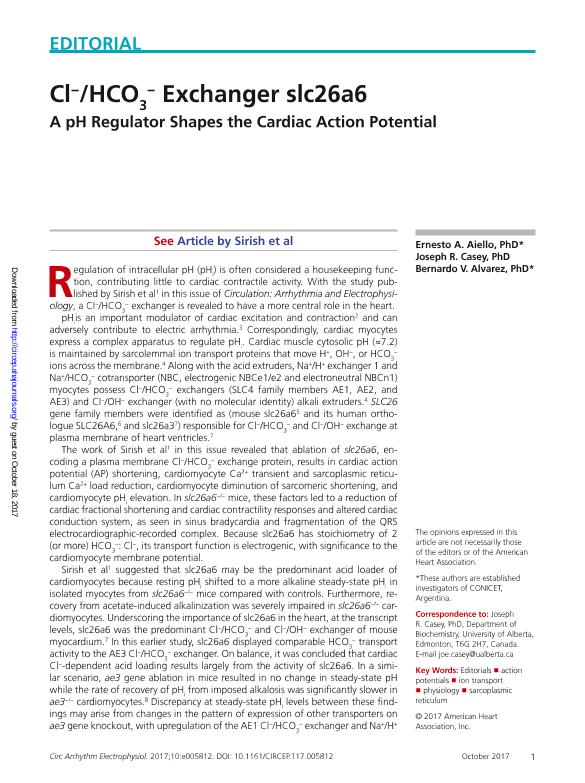Artículo
Cl−/HCO3− Exchanger slc26a6: a ph regulator shapes the cardiac action potential
Fecha de publicación:
10/2017
Editorial:
Lippincott Williams
Revista:
Circulation-arrhythmia And Electrophysiology
ISSN:
1941-3149
Idioma:
Inglés
Tipo de recurso:
Artículo publicado
Clasificación temática:
Resumen
Regulation of intracellular pH (pHi) is often considered a ?housekeeping? function, contributing little to cardiac function. With the study published by Sirish et al7 in this issue of Circulation: Arrhythmia and Electrophysiology, a Cl-/HCO3- exchanger is revealed to have a more central role in cardiac function.Intracellular pH is an important modulator of cardiac excitation and contraction1, and adversely contributes to electrical arrhythmia2. Cardiac myocytes express a complex apparatus to regulate pHi. Cardiac muscle cytosolic pH (~7.2) is maintained by sarcolemmal ion transport proteins that move H+, OH− or HCO3− ions across the membrane3. Along with the acid extruders Na+/H+ exchanger (NHE1) and Na+/HCO3− cotransporter (NBC, electrogenic NBCe1/e2 and electroneutral NBCn1) myocytes possess Cl-/HCO3− exchangers (SLC4 family members AE1, AE2, and AE3) and Cl-/OH- exchanger (CHE, with no molecular identity) alkali extruders3. SLC26 gene family members were identified as (mouse slc26a64 and its human orthologue SLC26A65, and slc26a36) responsible for Cl-/HCO3− and Cl-/OH- at plasma membrane of heart ventricles6. The work of Sirish et al7 in this issue revealed that ablation of slc26a6, a plasma membrane Cl-/HCO3- exchange protein, results in cardiac action potential (AP) shortening, cardiomyocyte Ca2+ transient (CaT) and sarcoplasmic reticulum (SR) Ca2+ load reduction, cardiomyocyte diminution of sarcomeric shortening, and cardiomyocyte intracellular pH (pHi) elevation. Moreover, in slc26a6-/- mice these factors led to a reduction of cardiac fractional shortening and cardiac contractility responses, and alterations of cardiac conduction system, as seen in sinus bradycardia and fragmentation of the QRS electrocardiographic-recorded complex. Since slc26a6 has stoichiometry of 2 (or more) HCO3-: Cl-, its transport function is electrogenic, with significance to the cardiomyocyte membrane potential.
Palabras clave:
Action Potentials
,
Ion Transport
,
Physiology
,
Sarcoplasmatic Reticulum
Archivos asociados
Licencia
Identificadores
Colecciones
Articulos(CIC)
Articulos de CENTRO DE INVEST.CARDIOVASCULARES (I)
Articulos de CENTRO DE INVEST.CARDIOVASCULARES (I)
Citación
Aiello, Ernesto Alejandro; Casey, Joseph R.; Alvarez, Bernardo; Cl−/HCO3− Exchanger slc26a6: a ph regulator shapes the cardiac action potential; Lippincott Williams; Circulation-arrhythmia And Electrophysiology; 10; 10; 10-2017; 1-3
Compartir
Altmétricas




